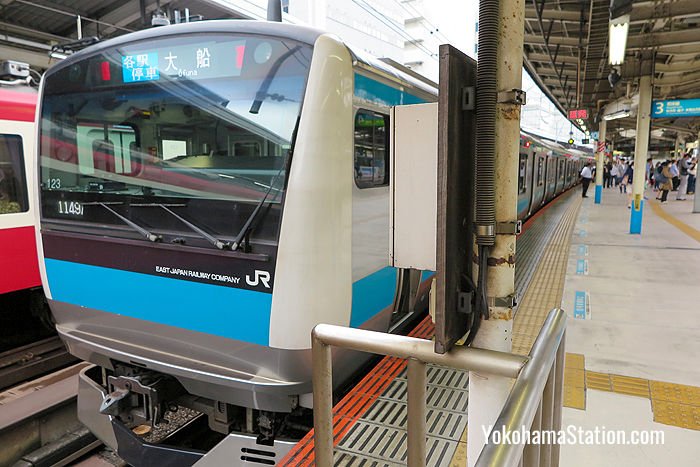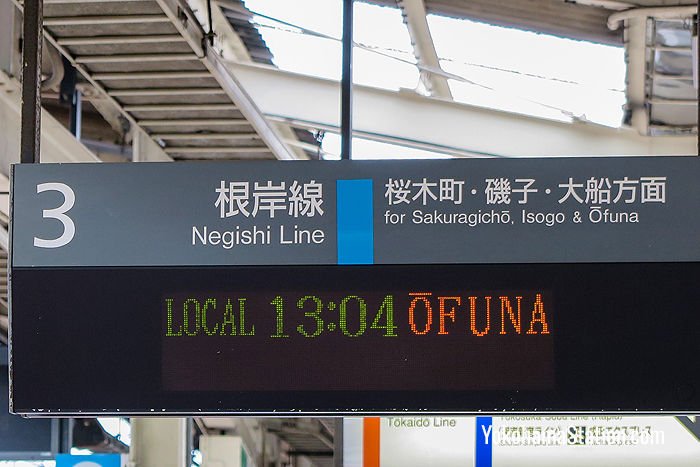The Negishi Line is a railway line operated by JR East that runs between Yokohama Station and Ofuna Station. This line connects Yokohama Station with some of Yokohama’s top sightseeing areas in the bay area such as Minato Mirai, Chinatown and Yamate, as well as destinations further south such as Ofuna in Kamakura City.

A Negishi Line train bound for Ofuna at Platform 3 Yokohama Station
At Yokohama Station Negishi Line services depart from Platform 3. This line is fully covered by the Japan Rail Pass.
Key Destinations
There are 12 stations on the Negishi Line.
Yokohama – Sakuragicho – Kannai – Ishikawacho – Yamate – Negishi – Isogo – Shin-Sugita – Yokodai – Konandai – Hongodai – Ofuna
The key destinations are listed below with example rail fares and journey times given from Yokohama Station.

Departure information at Platform 3, Yokohama Station
Yokohama Station
Yokohama Station is an important access point for Yokohama City. There are many department stores and shopping centers in and around the station which include Takashimaya, Lumine, and Yodobashi Camera. Nearby attractions include Hara Model Railway Museum, and Sogo Museum of Art which is located on the 6th floor of Sogo department store. Bay Quarter Yokohama is an attractive commercial complex with excellent waterfront dining facilities which can be accessed via the station’s Northeast and East exits.
Yokohama Station is a major transportation hub with several railway lines operated by JR East and private rail companies, as well as local and highway bus services. The Negishi Line can be used to access Yokohama’s main sightseeing locations around Minato Mirai, Chinatown and Yamate. Alternative services to these areas from Yokohama Station are the Minatomirai Line and Yokohama Municipal Subway’s Blue Line. The Subway’s Blue Line and JR’s Yokohama Line also link Yokohama Station to the Tokaido Shinkansen terminal at Shin-Yokohama Station. Other transfers can be made to JR East’s Yokosuka Line, Shonan-Shinjuku Line, and Tokaido Line, the Tokyu Toyoko Line, the Keikyu Main Line, the Sotetsu Main Line. Local and highway bus services depart from Yokohama City Air Terminal (YCAT) which can be found on the 1st floor of Yokohama Sky Building on the east side of the station.
Sakuragicho Station
Sakuragicho Station is convenient for the Minato Mirai waterfront district. Attractions in this area include Yokohama Museum of Art, Yokohama Port Museum and the Nippon Maru sailing ship, Cosmoworld amusement park, and the observation deck on the 69th floor of Yokohama Landmark Tower.
Transfers can be made here to the Yokohama Municipal Subway Blue Line.
Train fare: 146 yen
Train time: 3 minutes
Kannai Station
This station is convenient for Kanagawa Prefectural Museum of Cultural History and the NYK Maritime Musuem. Transfers can be made here to the Yokohama Municipal Subway Blue Line.
Train fare: 146 yen
Train time: 6 minutes
Ishikawacho Station
This station is convenient for Yokohama Chinatown, the shopping streets of Motomachi, and the historic Western style residences of the Yamate district.
Train fare: 160 yen
Train time: 8 minutes
Negishi Station
Yokohama Municipal Tram Museum is a 17 minute walk from Negishi Station.
Train fare: 170 yen
Train time: 14 minutes
Shin-Sugita Station
Transfers can be made here to the Kanazawa Seaside Line and to the Keikyu Main Line at nearby Sugita Station. The Kanazawa Seaside Line follows a scenic coastal route from Shin-Sugita Station to Kanazawa-Hakkei Station. There are some attractions on the way, such as the Yokohama Hakkeijima Sea Paradise theme park near Hakkeijima Station, Uminokoen beach near Uminokoen-Shibaguchi Station, or the beautiful garden of Shomyoji Temple near Uminokoen-Minamiguchi Station.
Train fare: 220 yen
Train time: 20 minutes
Ofuna Station
Ofuna Station is located in Kamakura City which is popular with tourists for its seaside location and many historical shrines and temples. Ofuna Kannon Temple with its 25 meter high statue of Kannon, the goddess of mercy, is a 5 minute walk from the station’s west exit. Josenji Temple and the Taya Caves are a 14 minute bus ride from the west exit of Ofuna Station. The meditation caves were dug into a limestone hill by the monks of Josenji and inside they are decorated with ancient Buddhist carvings.
To explore Kamakura further, passengers can take the Yokosuka Line to Kita-Kamakura Station and Kamakura Station as many shrines and temples are concentrated in those areas. Alternatively, passengers can take the Tokaido Line to the beach resorts of Fujisawa and the castle town of Odawara. Transfers can also be made at Ofuna Station to the Shonan Monorail which runs to Shonan-Enoshima Station in Fujisawa City.
Train fare: 310 yen
Train time: 16 minutes
Useful Links
Most Negishi Line services are through services that also run on either the Keihin-Tohoku Line toward Tokyo and Omiya, or on the Yokohama Line toward Shin-Yokohama and Hachioji. On JR East’s railway network route map the Negishi Line is listed with both of these through lines. With the Keihin-Tohoku Line it is numbered 4 and color-coded light blue. With the Yokohama Line it is numbered 6 and color-coded light green. To plan a journey on these lines we recommend English language route finders like the Japan Transit Planner or Hyperdia.
Article and original photos by Michael Lambe. All rights reserved.
